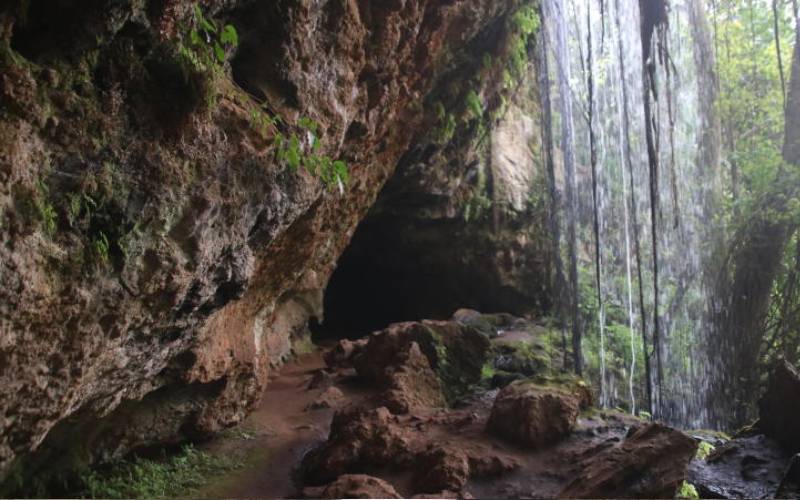
Waterfall at Paradise Lost in Kiambu where one can explore the stone age caves, experience waterfalls, picnics, fishing, boat riding, horse or camel riding, nature trails, bird watching with family and friends. May 28, 2022. [David Gichuru, Standard]
Weaving our way through a breathtaking tropical mini-forest, a little path leads us to the magnificent stone age caves, a hidden treasure in Paradise Lost in Kiambu.
Here, you find obsidian rocks dating back to the days of early man. Some volcanic activity took place in this neighbourhood years back. A National Museums of Kenya expedition uncovered human remains here dated back 8,000 to 12,000 years ago.
The caves make Paradise Lost in Kiambu an adventurer’s fortune. Rich with historical attractions, our guide, Alpha Mugira lets us know that this was a hide out for Mau Mau fighters.
It was one of the British Army’s bloodiest post-war conflicts, the Mau Mau revolt of 1952. This was one of the battlefields. “These caves were the hideouts for the Mau Mau. Scientists estimate they are 2.5 million years old. The obsidian rocks date back then. The obsidian rocks were also used by the stone age people for hunting,” says Mugira.
READ MORE
“Most of the freedom fighters were from Mount Kenya, and most were fighting from Kiambu County. Many Kenyans were fighting from forests. We did not have many caves and this is one of the few hideouts where our freedom fighters used to fight from,” he says we go past what looks like a gateway into the caves.
Giant mugumo trees have their roots weaving through the huge rocks. They look symbolic, almost immortal. Traditionally, Kikuyus believe the mugumo tree was sacred.
The caves are deep and dark, with narrow entries. This is not a place for the faint-hearted. My colleague opts out as a team of three of us forge ahead. We are given torches to help light the way as we crawl metres deep into the natural void. Inside, the caves are spacious, underground houses enough for human habitation.
Feeding the fun
The caves were re-discovered officially by Joseph Mbai and a group of coffee farmers in 1996. Above the caves is an impressive 3.5 metres wide cascading waterfall fed by the nearby Gichi River that feeds into a large manmade lake. The waterfall is surrounded by natural rocks, and over 100-year-old trees, and acts as a curtain to the caves.
Mugira lets us know that the Gichi River feeds into three man-made dams and has been key to the ecosystem of Paradise Lost.
“This scene has been used by many moviemakers to shoot international films. It is an ideal place for therapy too. It has also been used by lovers for weddings and honeymoons and anniversaries. Most of the trees here are indigenous, with some being used for medicinal purposes,” he says.
This oasis is in the middle of a coffee plantation that is also part of its rich history. The coffee plantations were also used as hideout places by Mau Mau freedom fighters.
Growing up, we knew Paradise Lost, more as a place where we would do picnics and enjoy horse riding. Being only 14 kilometres from Nairobi City, it was the ideal place one would visit for a weekend getaway.
But at some point, the place was run down and almost got forgotten. After a while, it was re-opened, with more fun activities incorporated. Bicycle riding and archery games are part of the new attractions.
In July 2015, the caves were officially opened to the world in an event that involved government officials as well as Mukami Kimathi, wife of freedom fighter Dedan Kimathi.
Now, the spot has partnered with Kenya Wildlife Service, the Ministry of Education and the National Museum of Kenya to preserve its historical value and also offer an educational experience to schools, colleges, universities and other institutions.
From birdwatching to camping, boat riding to fishing, camel and horse rides as well as coffee tours and zip-lining, the 54-acre treasure has enough attractions for everyone’s treat.
As we start the tour, we are introduced to the latest attraction, two domesticated Llamas popularly known as the South American camelid. “Llamas are social animals. They are friendly and easy to domesticate. Llamas are believed to have originated from the Great Plains of North America about 40 million years ago,” says Mugira.
Nature trails and camping are popular among groups that visit Paradise Lost.
Water sports such as rafting and kayaking are the other main activities available for visitors who love an adrenaline rush. The zip line runs from one end of the lake to the other.
smuendo@standardmedia.co.ke

